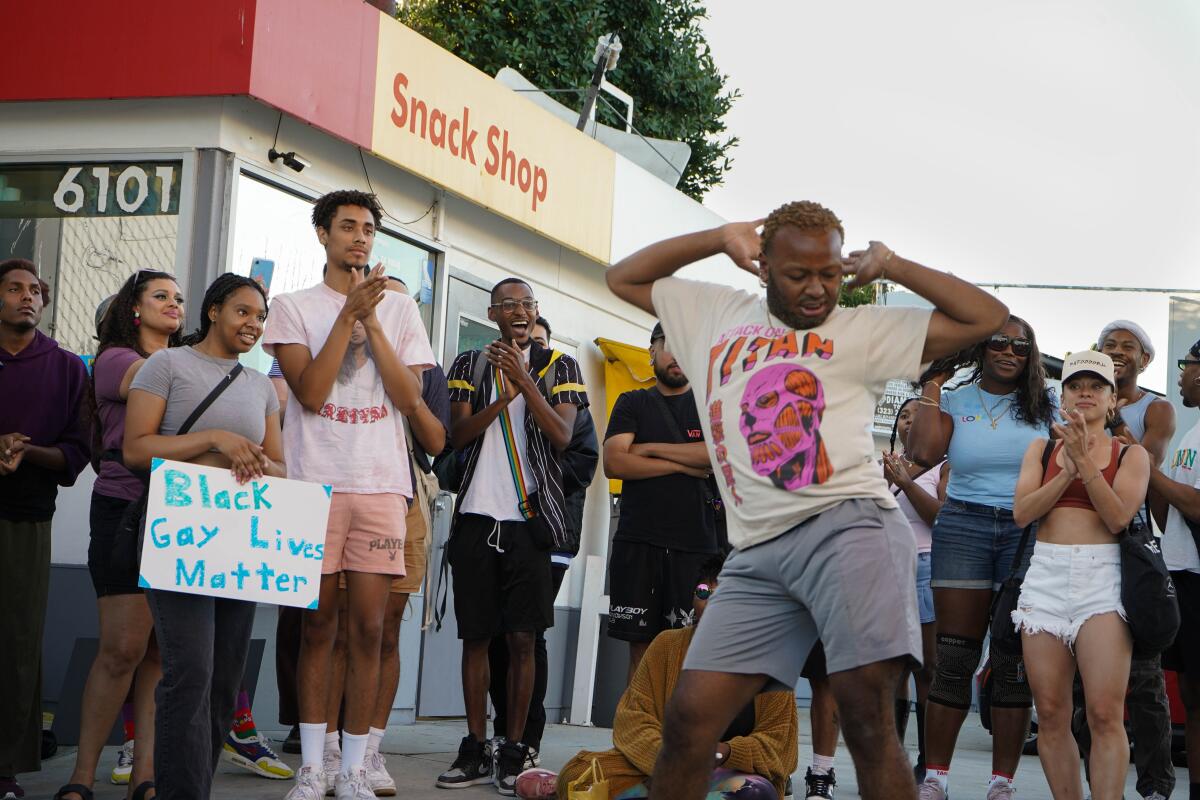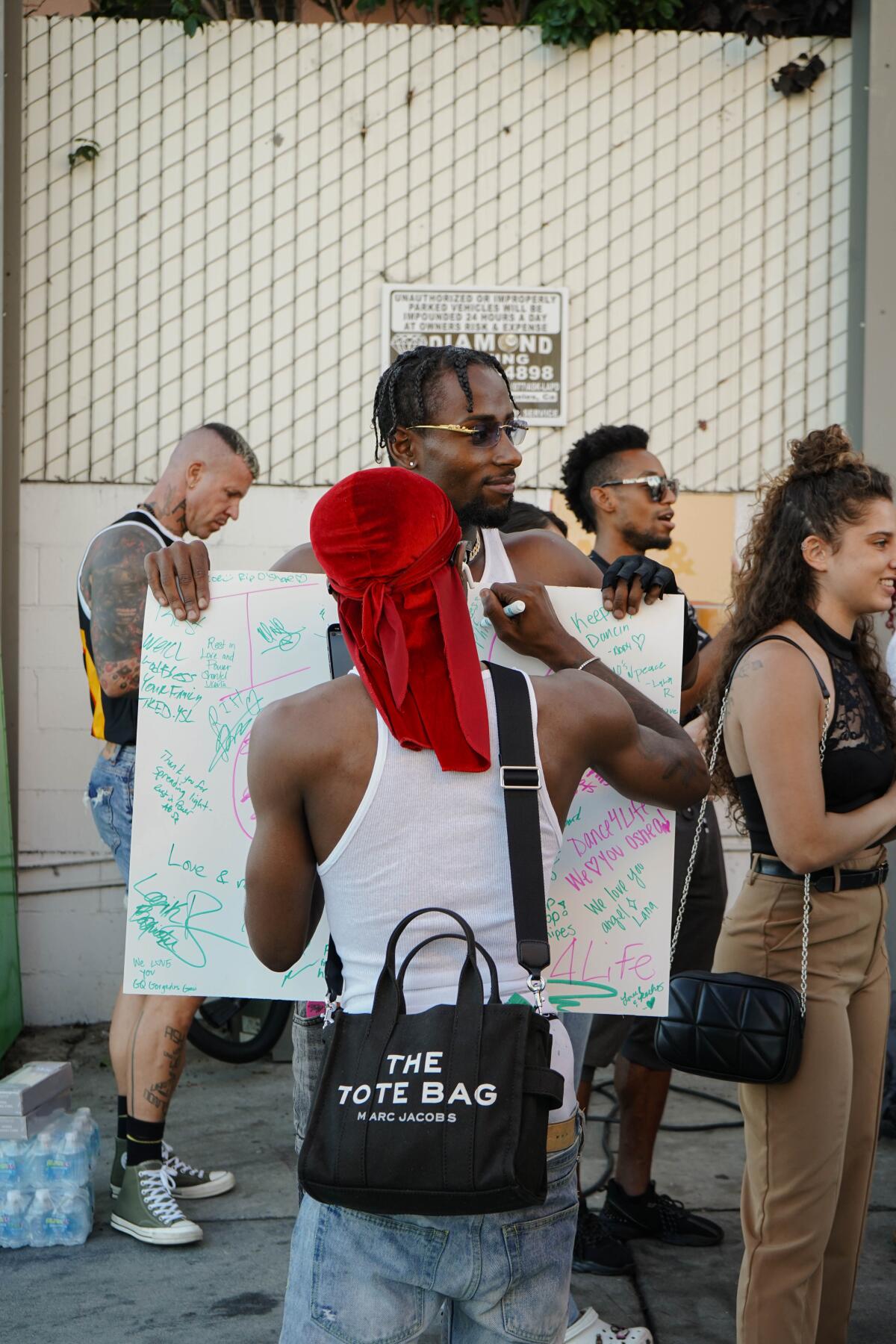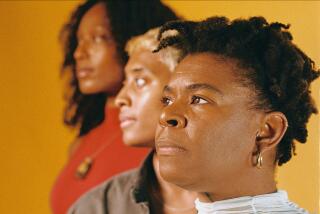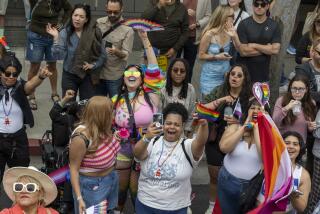Vogue as resistance: L.A. ballroom scene protests O’Shae Sibley death with dance at a gas station

- Share via
Dozens of members from the West Coast ballroom community gathered at a central Los Angeles gas station Friday evening to dance in protest of the death of O’Shae Sibley.
Sibley was fatally stabbed at a gas station in Brooklyn on July 29 after he vogued to Beyoncé music near the gas pumps. The L.A. protesters on Friday gathered in a circle at a Shell station (unconnected to the Sibley killing) and began voguing their way to the center. One person entered, swinging their arms in sharp movements and tilting their head back into a dip while others chanted, “Say his name: O’Shae.”
The New York Police Department took into custody a 17-year-old suspect who turned himself in Friday, according to a tweet from New York City Councilwoman Inna Vernikov. The suspect, whose identity has not been released, was charged with second-degree murder, the New York Times reported Saturday.

The protest in L.A. was one of several nationwide that began with a viral Facebook post from Malik Miyake Mugler, a New York ballroom leader known for his appearance in the HBO series “Legendary.”
“Ballroom need to come together go to the gas station where OShae was killed and have the biggest function ever,” he wrote in the post.
The first protest was in New York, organized by ballroom folks such as Gia Love and Qween Jean, and took place at the same gas station where Sibley was stabbed. Similar events took place in Seattle, Dallas and other communities.
“I think it’s an opportunity for everyone to really come together in different spaces, in different states, in different areas because it could have happened to any one of us,” said Dashaun Wesley, who helped to organize the gathering in L.A. with Isla Ebony. Trey Haines, a leader in ballroom on the West Coast, led the protest.

Haines pulled out a bullhorn and shouted, “Pump the beat.” Music blasted out of speakers, and protesters touched posters that read “R.I.P. O’Shae Sibley,” “Justice for O’Shae” and “Rest in Power.” Then people got to their feet to dance.
The protests centered on vogue as resistance. The dance style, born out of the ballroom scene in Harlem in the 1980s as a source of joy and expression, became a response to a stabbing feared to be an attack on queerness and Blackness, Jean said.
“I think that this is something that is spilling over nationally with all of the growing anti-LGBTQ legislation,” Love said. “I think that it has emboldened people who are bigots to perpetrate violence against people who are only doing things to be free.”

Vogue and ballroom entered the mainstream with TV shows including “Legendary” and “Pose.” In 2022, Beyoncé’s latest album, “Renaissance,” paid homage to ballroom culture and brought new eyes and ears to the scene.
“There’s always been a spotlight on the community with respect to voguing and the performance, but I feel like there’s a lack of interest in the real lives and the stories of the people who vogue,” Love said. “People are fascinated by the movement but don’t care about the people because the people are Black and brown.”
For Wesley, the protests are a way to show Angelenos where the movement comes from.

“O-O-O-Shae. He was voguing to Beyoncé,” the protesters chanted Friday.
Following Sibley’s death, Beyoncé swiftly supported the community by adding “REST IN POWER O’SHAE SIBLEY” to the top of her website. During her current concert tour, she brings out members from the scene such as Honey Balenciaga and Carlos Basquiat as the show turns into a ballroom floor.
“I think it’s an eye-opening moment,” Ebony said. “O’Shea was dancing to Beyoncé, and Beyoncé’s whole album celebrates Black queerness, so there’s been this permission to be very out loud. This is a reminder. ... We have to be safe. We have to be diligent.”

Wesley joined ballroom as a teenager and found a sense of belonging. His experience is part of what influenced him to organize the L.A. protest.
“It just puts a smile on my face to know that there are people out there who care about this community just as much as I do, and want to put in that work and effort to make sure that we are seen and heard,” he said.
Haines took the L.A. protest to the street. When street lights turned red at the corner of Olympic Boulevard and Fairfax Avenue, protesters stepped in front of cars, held up their signs and danced. One driver stepped out of her car to vogue, and protesters cheered her on. Polina Glen Basquiat leaned back on the hood of her car, swinging her legs to the beat. The crowd screamed, “O’Shae,” laughing and throwing up their hands in disbelief.

After about two hours, protesters took over the center of the gas pumps, turning the space into an impromptu dance battle. Commentators repeated Sibley’s name over the beat of the music as voguers dueled. Dancers eased to the ground, rolled and propped themselves up into a duckwalk — feeding into the crowd’s energy. In that moment, the space emanated joy — and mourning transformed into solidarity and strength.
“That could have been any one of our children feeling cute, feeling liberated, feeling fabulous, and decided to vogue — do something that makes them feel free — and then they’re taken away from us,” Love said.
Violence against the LGBTQ+ community has been on Love’s mind. Before Sibley, a gay teen was allegedly murdered in Brooklyn — shot, burned and left on train tracks in February.
“These attacks are personal attacks,” she said.
Jean hoped that the protests can help “start that journey to healing.”
More to Read
The biggest entertainment stories
Get our big stories about Hollywood, film, television, music, arts, culture and more right in your inbox as soon as they publish.
You may occasionally receive promotional content from the Los Angeles Times.











